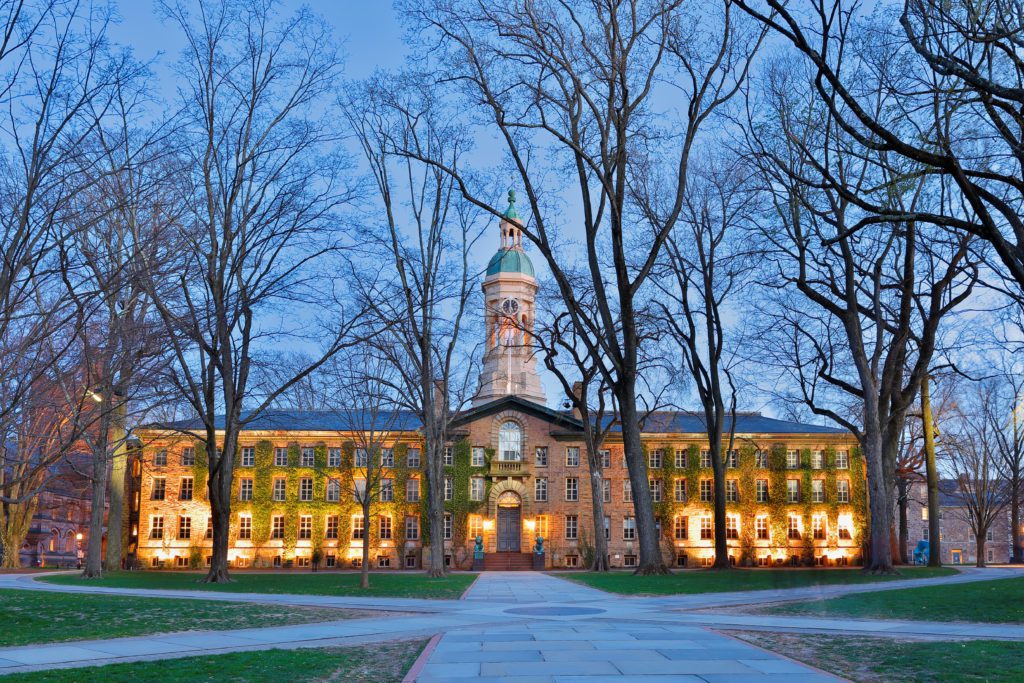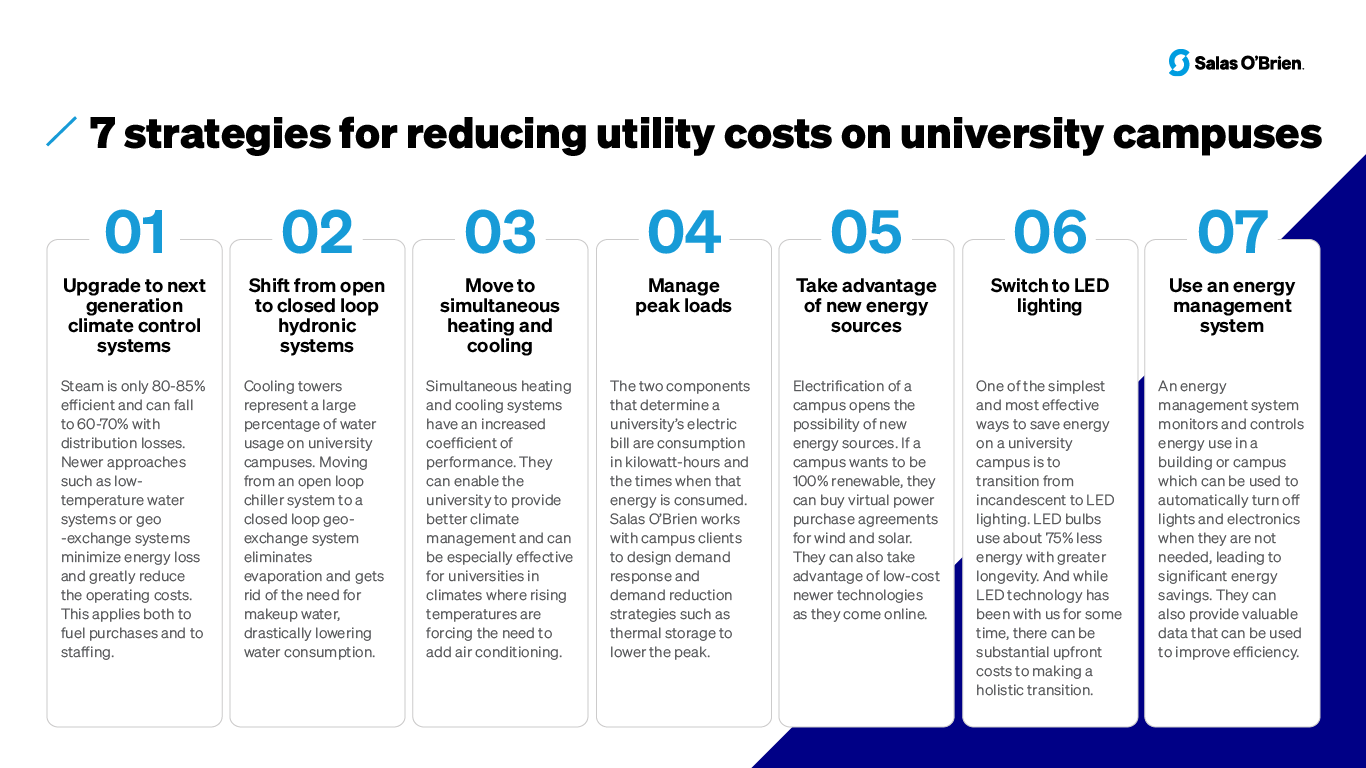News & Insights
7 strategies for reducing utility costs on university campuses
Salas O'Brien is making a major impact by helping universities increase their energy efficiency and reduce utility costs with dramatic results.

Whether you are a university with the benefit of contiguous land or an inner-city campus with buildings sandwiched by commercial properties, your site’s systems and circumstances create opportunities unique to you.
Every day, you deal with your own mix of building constraints, utility offerings, aging technologies, and deferred maintenance. Add to that stress volatility in energy pricing, weather events, and the goal to meet The Presidents’ Climate Leadership Commitment, and the pressure becomes exponential.
The good news is that there are many angles from which to seek improvement. Here are some of the opportunities that university campuses are leveraging to reduce utility costs and create resilience.
7 strategies for reducing utility costs on university campuses
1. Upgrades to next generation climate control systems
If on an autumn day you can walk your campus and see steam clouds rising, consider that you are paying for every bit of energy that is being lost out of the ground.
Steam is only 80-85% efficient and can fall to 60-70% with distribution losses. Newer approaches such as low-temperature water systems or geo-exchange systems save on energy loss and greatly reduce the operating costs. This applies both to fuel purchases and to staffing. Boilers require a licensed stationary engineer onsite for three shifts, seven days a week to operate safely—and boiler operators are difficult to find. Many experts are nearing retirement with few new engineers training to take their places.
Next generation plants, like geo-exchange, can run unstaffed at year-round efficiencies of up to 500%. Next generation systems are also safer. A boiler runs at 300°F, making leaks a present danger. Low temperature systems can run at a much safer 120°F.
Another savings when converting from steam? Universities with boilers spend about $30,000 in the annual Relative Accuracy Test Audit for EPA compliance to maintain their permit. Newer generation systems don’t require this testing.
2. Shift from open to closed loop hydronic systems
Cooling towers represent a large percentage of water usage on university campuses. Moving from an open loop chiller system to a closed loop geo-exchange system eliminates evaporation and gets rid of the need for makeup water, drastically lowering water consumption.
Not only that, but open cooling towers have to protect from aerobic and anerobic bacteria. Eliminating the need for biocides and the chemicals used to maintain pH balance reduces maintenance costs and improves safety.
3. Move to simultaneous heating and cooling
Most university climate control systems provide heating in the winter and cooling in summer. But it’s not unusual to walk past a dormitory in the middle of winter to see windows open to try to cool a room that is overheated. And many space uses require cooling year-round such as freezers, data closets, and some laboratories.
Simultaneous heating and cooling systems aren’t only useful by sharing energy between buildings, but they also have an increased coefficient of performance. They enable the university to provide better climate management and comfort to residence halls and classrooms. This is especially effective for universities in climates where rising temperatures are forcing the need to add air-conditioning. Rather than adding AC units with loud, ugly condensers, they can select an efficient heat pump system that meets both heating and cooling needs.
4. Manage peak loads
While there are efficiencies in electrifying a college campus, you do have to manage peak loads. The two components that determine a university’s electric bill are consumption in kilowatt-hours and the times when that energy is consumed.
Salas O’Brien works with campus clients to design demand response strategies and demand reduction strategies such as thermal storage to lower the peak and control costs.
5. Take advantage of new energy sources
Electrification of a campus opens the possibility of new energy sources. If a campus wants to be 100% renewable, they can buy virtual power purchase agreements for wind and solar. They can also take advantage of low-cost newer technologies as they come online. Electrification prevents campuses from being tied into a single commodity like natural gas—the question is determining when it makes sense.
For some projects, burning natural gas for heat may still be cheaper than full electrification. But with the volatility of gas prices and the introduction of carbon taxes, that paradigm continues to shift. A campus energy plan can help you determine where you want to be and break the effort into smaller projects across a budget and timeline.
6. Lighting refurbishment
One of the simplest and most effective ways to save energy on a university campus is to transition from incandescent to LED lighting. LED bulbs use about 75% less energy than incandescent bulbs with greater longevity, and while LED technology has been with us for some time, there can be substantial upfront costs to making a holistic transition.
7. Implement an energy management system
An energy management system monitors and controls energy use in a building or campus. These systems can be used to automatically turn off lights and electronics when they are not needed, which can lead to significant energy savings. Additionally, they can provide online monitoring and valuable data that can be used to further improve energy efficiency on campus.

How does a university get started with an energy transition plan?
Over a 10-year timeline, Miami University was able to reduce their annual campus utility bills for electric and natural gas from $12 million to $5 million with 25% percent growth in campus square footage. While these results might seem like an outlier, Salas O’Brien is helping many universities achieve significant savings.
The work starts with an assessment that gives the university a clear view of where they are now in relation to their goals. It’s about identifying what can be delivered in the long-term and how to create quick wins in the short term.
Our team works with yours to determine which initiatives will have the best benefit for your unique scenario. We then work with you to create a timeline and outline the resources you need to achieve this. We can also help you benchmark against other universities and set realistic timelines.
Curious what is possible for your campus?
Salas O’Brien has a deep track record in working with university systems on long-term transition plans that reimagine their infrastructure. These plans are used to explain to trustees, finance and facility teams, students, and the community how the shift will be implemented highlighting the financial and sustainability benefits.
If you want to know more about developing an energy plan for your campus, reach out to us and we will connect you with an expert local to you.
Contact us to learn more.
For media inquiries on this article, reach out to Stacy Lake.
Decarbonization in Higher Education

Doug Hammerle
Doug Hammerle is a subject matter expert on campus utilities who works with clients on campus master plans. He spent the first part of his career on the client side as the Director of Energy Systems for Miami University. This experience empowered him with a deep personal perspective on the challenges higher education clients face. Doug is an expert in developing strategies that improve efficiencies and eliminate waste. Doug is an Associate Vice President at Salas O’Brien. Contact him at [email protected]

Lindsey Olsen, PE, PMP
Lindsey Olsen is deeply experienced in campus sustainability and engineering projects. She specializes in helping campuses transition to newer generation, more sustainable technologies, and is skilled in decarbonization and program management. Lindsey holds a Master of Science in Mechanical Engineering from the University of Minnesota and a Bachelor’s Degree in Environmental Studies and Physics from Hamline University. Lindsey serves as an Associate Vice President at Salas O’Brien. Contact her at [email protected].

Tom Iskra, PE, LEED AP
Tom Iskra has over 20 years of experience in project management, design and construction of innovative projects that maximize efficiency and minimize the impacts on the environment. Tom is actively involved with decarbonization efforts at Tufts University, Northeastern University and various public institutional campuses across the Northeast. Tom holds a Bachelor’s degree from the University of Connecticut and Master’s degrees from University of California, Berkeley and Harvard University’s Graduate School of Design. Tom serves as a Principal at Salas O’Brien. Contact him at [email protected]